Analysis of the Possibility of Making a Digital Twin for Devices Operating in Foundries
Abstract
1. Introduction
- DT of a stand-alone unit for growing fish and vegetables using the aquaponics method—This running prototype of the twin uses information about the temperature, light intensity, pH and salts dissolved in the water to create a simulation of how the fish should be fed, all in order to find the optimal behavior of the entire system. This is conducted by determining the ideal changes in fish weight and aquatic plant growth to maximize the finished products while finding water savings, minimizing waste production and maintaining quality standards and secondary production goals.
- DT of bee families—a twin introduced to monitor nectar, prevent pests and maintain health among individuals. It is based on GPS data with sensors of the humidity, temperature inside and outside the apiary and the weight of new creatures in the hatchery. Beekeepers monitor the hives in real time, make decisions about interaction, remotely determine food doses and identify anomalies, hygiene and the colony life stages. At the same time, they minimize contact between bees and humans, without interfering with natural processes.
- DT tractors—Modern tractors are equipped with modern and autonomous interfaces with which they can be integrated to achieve even greater benefits. This twin was introduced to actively monitor the device’s health and prevent faults. In this way, downtime is minimized, which significantly determines the size of the harvest, and therefore the farmers’ earnings.
2. Materials and Methods
2.1. Data Analysis for Algorithms
- Temperature [°C]—current sample temperature,
- Resistance [Ω]—sample resistance value in a given second,
- Voltage [V]—value of the current measurement at both ends of the sample,
- Current [A]—information about the current stage of the cycle (if 330 A, the heating process is maintained; if 10 A, cooling is in progress),
- Force [N]—which the sample exerts on the material on the machine arms,
- Elongation [mm]—the length by which the sample shrank or expanded in the last second,
- Cycle number—iteration of the entire cycle (heating and cooling) current for a given second,
- Test time—in seconds, point at which the remaining data were downloaded from the start of the test.
2.2. Prediction Algorithms
2.3. API and UI
3. Results
3.1. Implementation of Scripts Using Artificial Intelligence
- Samples—time frames with the data currently taken into account, e.g., one hundred seconds
- Timesteps—data in specific seconds, i.e., subsequent lines of the .csv file
- Features—individual data of each row that we want to use to fit the model.
- z—is the new value,
- x—currently read from the data table,
- u—average value,
- s—standard deviation.
3.2. Results Analysis
4. Discussion and Conclusions
Author Contributions
Funding
Data Availability Statement
Conflicts of Interest
References
- Akash, S.S.; Ferdous, M.S. A Blockchain Based System for Healthcare Digital Twin. IEEE Access 2022, 10, 50523–50547. [Google Scholar] [CrossRef]
- Fahim, M.; Sharma, V.; Cao, T.-V.; Canberk, B.; Duong, T.Q. Machine Learning-Based Digital Twin for Predictive Modeling in Wind Turbines. IEEE Access 2022, 10, 14184–14194. [Google Scholar] [CrossRef]
- D’Amico, R.D.; Erkoyuncu, J.A.; Addepalli, S.; Penver, S. Cognitive digital twin: An approach to improve the maintenance management. CIRP J. Manuf. Sci. Technol. 2022, 38, 613–630. [Google Scholar] [CrossRef]
- Lei, Z.; Zhou, H.; Hu, W.; Liu, G.-P.; Guan, S.; Feng, X. Toward a Web-Based Digital Twin Thermal Power Plant. IEEE Trans. Ind. Inform. 2022, 18, 1716–1725. [Google Scholar] [CrossRef]
- Azangoo, M.; Sorsamäki, L.; Sierla, S.A.; Mätäsniemi, T.; Rantala, M.; Rainio, K.; Vyatkin, V. A Methodology for Generating a Digital Twin for Process Industry: A Case Study of a Fiber Processing Pilot Plant. IEEE Access 2022, 10, 58787–58810. [Google Scholar] [CrossRef]
- Fuller, A.; Fan, Z.; Day, C.; Barlow, C. Digital Twin: Enabling Technologies, Challenges and Open Research. IEEE Access 2020, 8, 108952–108971. [Google Scholar] [CrossRef]
- Wu, Y.; Zhou, L.; Zheng, P.; Sun, Y.; Zhang, K. A digital twin-based multidisciplinary collaborative design approach for complex engineering product development. Adv. Eng. Inform. 2022, 52, 101635. [Google Scholar] [CrossRef]
- Park, D.; You, H.J. A Digital Twin Dam and Watershed Management Platform. K-Water Research Institute. Water 2023, 15, 2106. [Google Scholar] [CrossRef]
- OVHcloud, Co to Jest API REST? Available online: https://www.ovhcloud.com/pl/learn/what-is-restapi/ (accessed on 4 September 2023).
- Shumway, R.H.; Stoffer, D.S. ARIMA Models. In Time Series Analysis and Its Applications; Springer Texts in Statistics; Springer: Cham, Switzerland, 2017. [Google Scholar] [CrossRef]
- Yadav, M.; Alam, M.A. Dynamic time warping (DTW) algorithm in speech. Int. J. Res. Electron. Comput. Eng. 2018, 6, 524–528. [Google Scholar]
- Sherstinsky, A. Fundamentals of Recurrent Neural Network (RNN) and Long Short-Term Memory (LSTM) network. Phys. D Nonlinear Phenom. 2020, 404, 132306. [Google Scholar] [CrossRef]
- Christos, P.; Sjoukje, O.; Ioannis, N.A. Introducing digital twins to agriculture. Comput. Electron. Agric. 2021, 184, 105942. [Google Scholar]

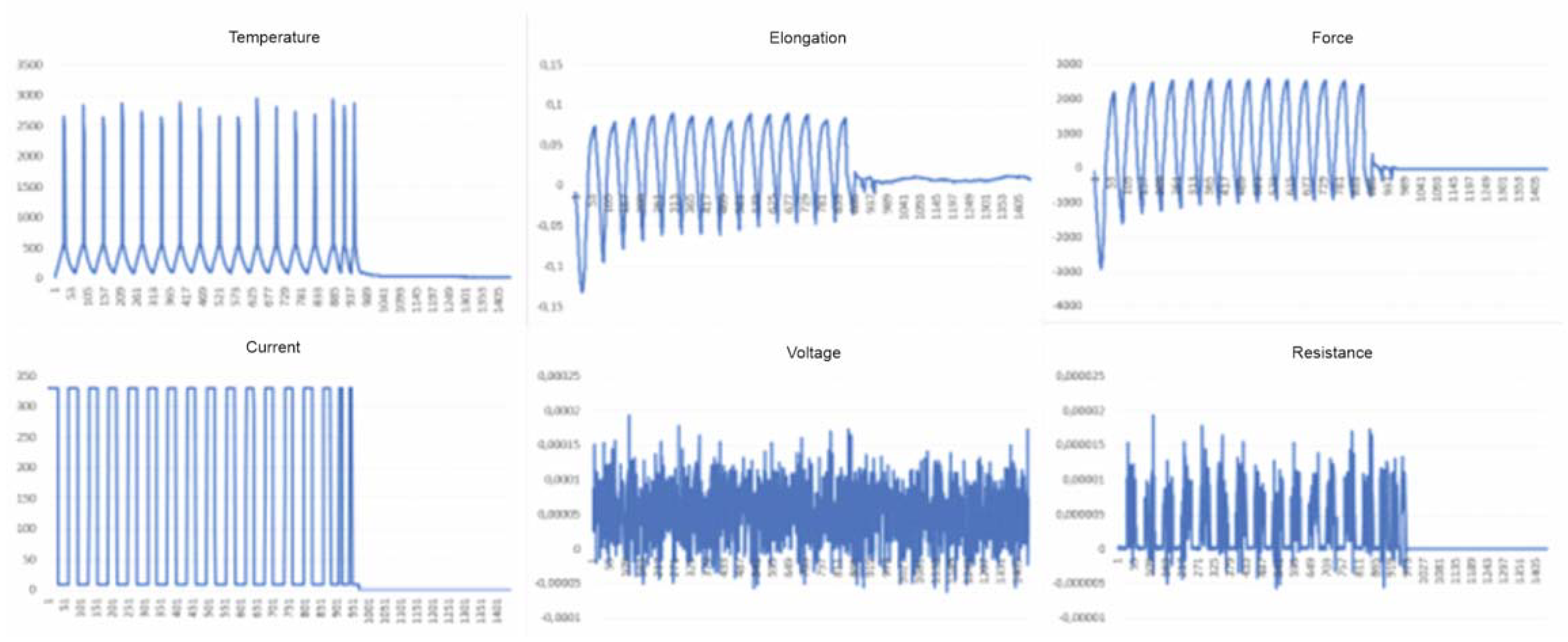
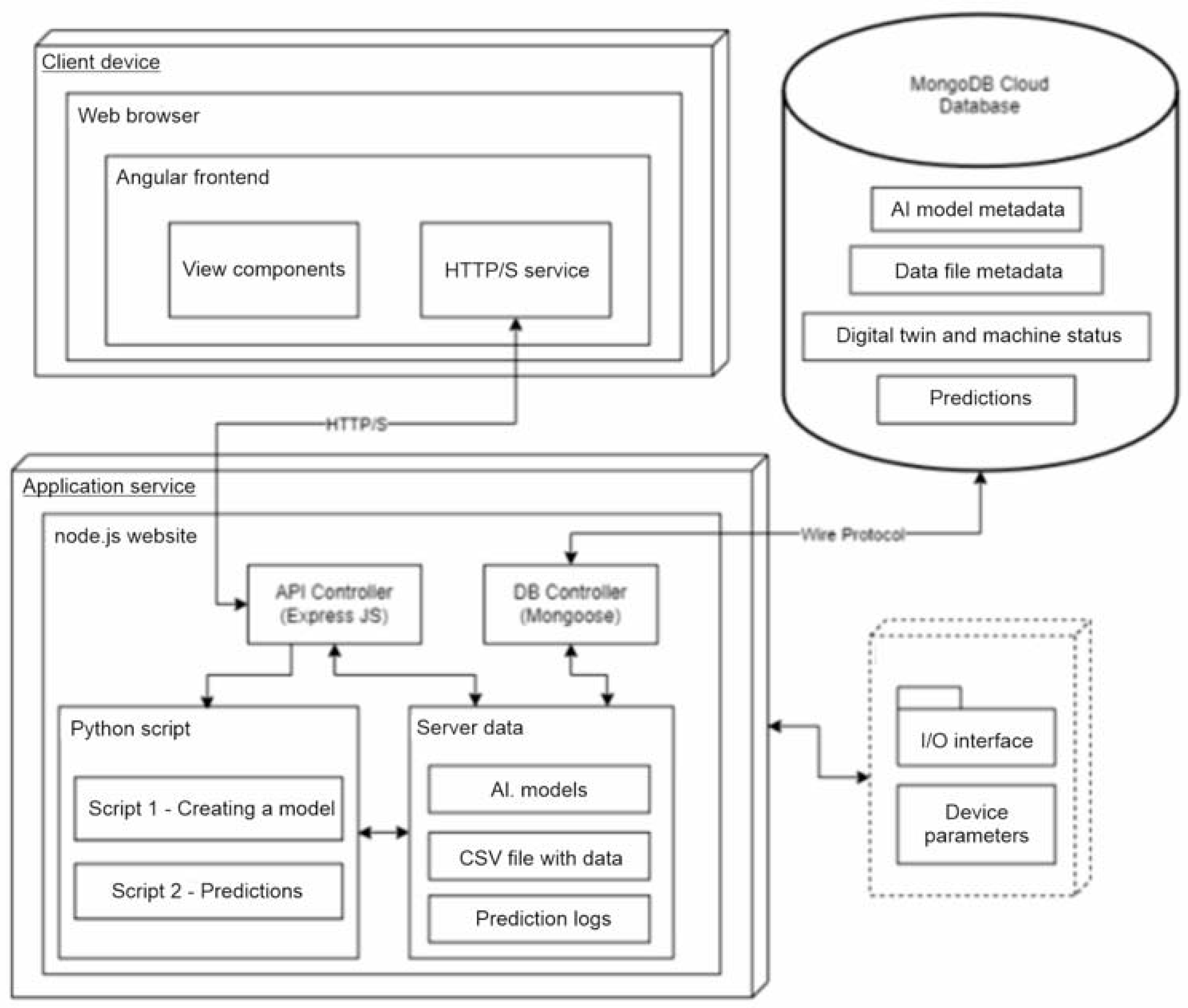
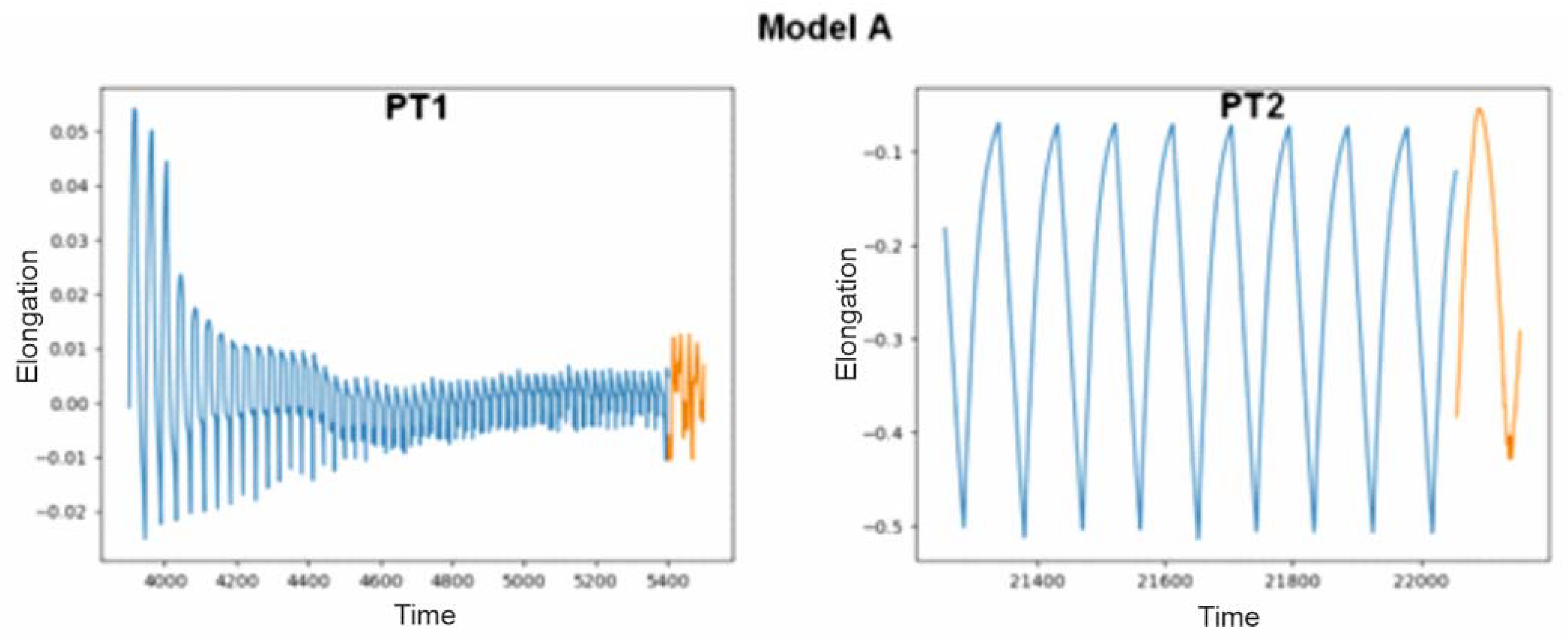
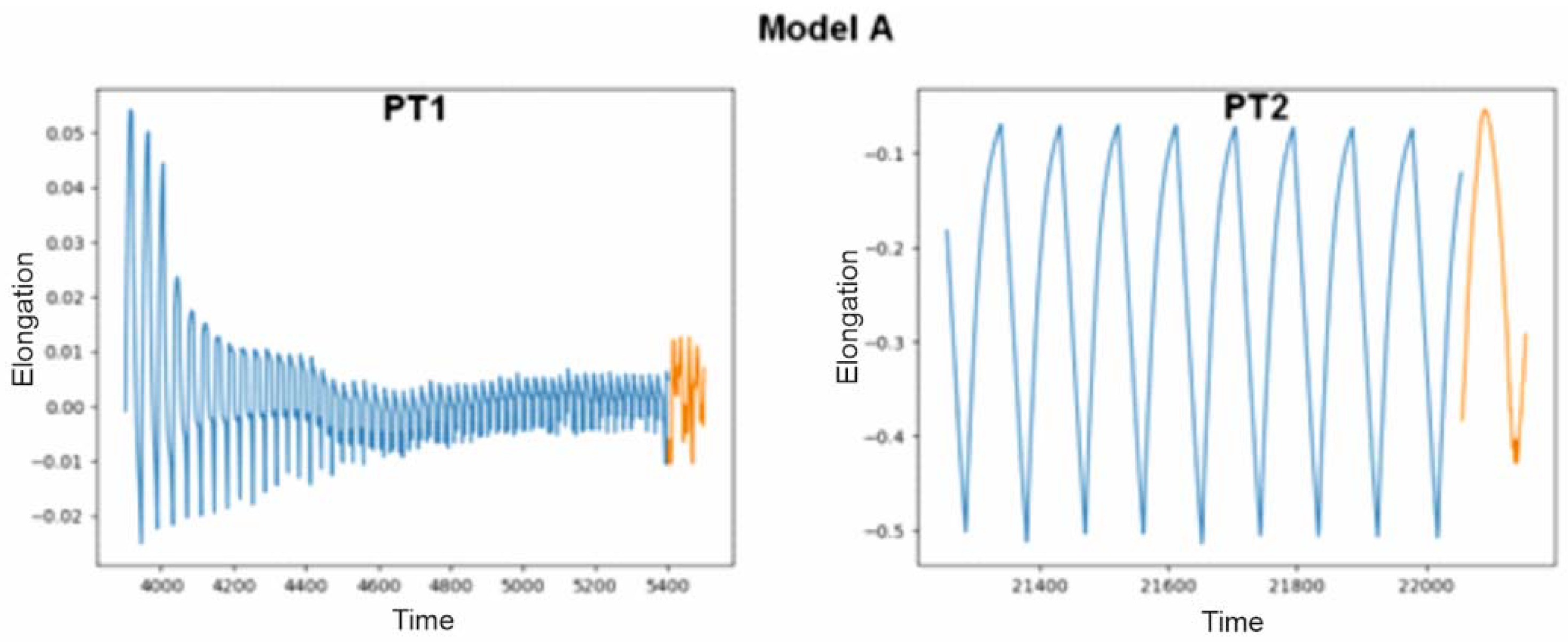
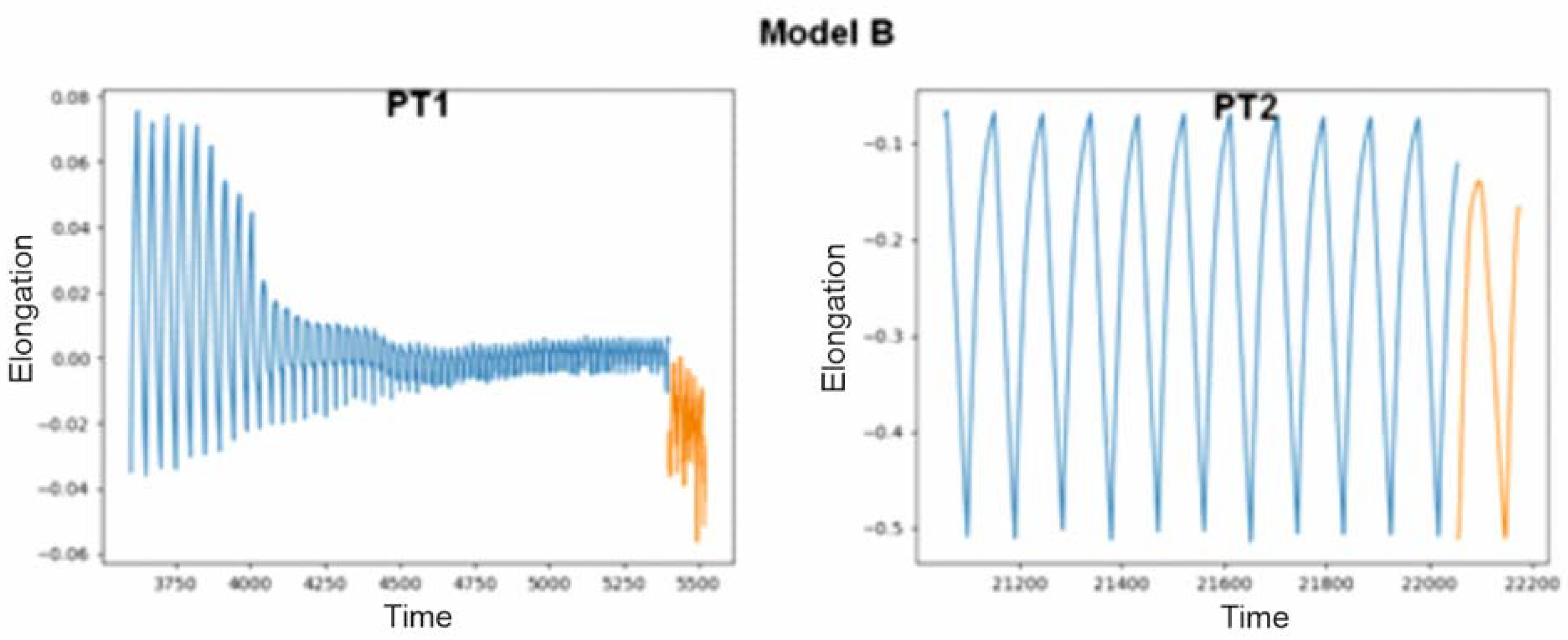

| Model Code | File with Training Data | Time in the Past [s] | Time in the Future [s] | Number of Training Epochs | Validation Error from the Training Stage |
|---|---|---|---|---|---|
| A | File 1—ended with a sample break | 500 | 120 | 10 | 0.043 |
| B | File 2—completed without interruption | 600 | 100 | 8 | 0.062 |
| C | File 3—completed without interruption | 600 | 100 | 8 | 0.037 |
| File Code | Time [s] | Number of Cycles | Termination |
|---|---|---|---|
| PT1 | 5400 | 130 | Aims to abort in a hundred seconds |
| PT2 | 22,055 | 230 | No interrupt |
Disclaimer/Publisher’s Note: The statements, opinions and data contained in all publications are solely those of the individual author(s) and contributor(s) and not of MDPI and/or the editor(s). MDPI and/or the editor(s) disclaim responsibility for any injury to people or property resulting from any ideas, methods, instructions or products referred to in the content. |
© 2024 by the authors. Licensee MDPI, Basel, Switzerland. This article is an open access article distributed under the terms and conditions of the Creative Commons Attribution (CC BY) license (https://creativecommons.org/licenses/by/4.0/).
Share and Cite
Lehrfeld, A.; Jaśkowiec, K.; Wilk-Kołodziejczyk, D.; Małysza, M.; Bitka, A.; Marcjan, Ł.; Głowacki, M. Analysis of the Possibility of Making a Digital Twin for Devices Operating in Foundries. Electronics 2024, 13, 349. https://doi.org/10.3390/electronics13020349
Lehrfeld A, Jaśkowiec K, Wilk-Kołodziejczyk D, Małysza M, Bitka A, Marcjan Ł, Głowacki M. Analysis of the Possibility of Making a Digital Twin for Devices Operating in Foundries. Electronics. 2024; 13(2):349. https://doi.org/10.3390/electronics13020349
Chicago/Turabian StyleLehrfeld, Artur, Krzysztof Jaśkowiec, Dorota Wilk-Kołodziejczyk, Marcin Małysza, Adam Bitka, Łukasz Marcjan, and Mirosław Głowacki. 2024. "Analysis of the Possibility of Making a Digital Twin for Devices Operating in Foundries" Electronics 13, no. 2: 349. https://doi.org/10.3390/electronics13020349
APA StyleLehrfeld, A., Jaśkowiec, K., Wilk-Kołodziejczyk, D., Małysza, M., Bitka, A., Marcjan, Ł., & Głowacki, M. (2024). Analysis of the Possibility of Making a Digital Twin for Devices Operating in Foundries. Electronics, 13(2), 349. https://doi.org/10.3390/electronics13020349






